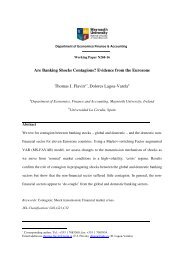n?u=RePEc:dnb:dnbwpp:463&r=ban
n?u=RePEc:dnb:dnbwpp:463&r=ban
n?u=RePEc:dnb:dnbwpp:463&r=ban
You also want an ePaper? Increase the reach of your titles
YUMPU automatically turns print PDFs into web optimized ePapers that Google loves.
equired to maintain a minimum CET1 ratio of 8 percent under the baseline scenario (as<br />
for the AQR) and a minimum CET1 ratio of 5.5 percent under the adverse scenario.<br />
The AQR showed that as of end-2013 the carrying values—or book values—of<br />
banks’ assets need to be adjusted by €48 billion, which will be reflected in the banks’<br />
accounts or prudential requirements. Furthermore, using a standard definition for nonperforming<br />
exposures (any obligations that are 90 days overdue, or that are impaired or<br />
in default), the review found that banks’ non-performing exposures increased by €136<br />
billion to a total of €879 billion. The assessment found a capital shortfall of almost €25<br />
billion at 25 (mainly small and medium-sized) banks (see Table 1). Most of these banks<br />
were located in Southern Europe: nine of the banks are Italian, while Cyprus and Greece<br />
are each home to three banks, Belgium and Slovenia two, and Austria, France, Germany,<br />
Ireland, Portugal, and Spain one. Twelve of the 25 banks covered their capital shortfall<br />
by increasing capital by €15 billion in 2014. The Comprehensive Assessment also showed<br />
that a severe scenario would deplete the banks’ top-quality, loss-absorbing Common<br />
Equity Tier 1 (CET 1) capital by about €263 billion. This would result in the banks’<br />
median CET1 ratio decreasing by 4 percentage points from 12.4 to 8.3 percent. 3<br />
[Insert Table 1 here]<br />
Most market participants consider the Comprehensive Assessment much more<br />
credible than previous EBA stress tests, but some academics are critical. According to de<br />
Groen (2014), one weakness of the Comprehensive Assessment is that the ECB focused<br />
purely on the CET1 ratio, which is based on risk-weighted assets. de Groen has<br />
calculated capital shortfalls under several alternative criteria, one of them being the<br />
leverage ratio. His calculations suggest that 34 banks would require almost €21 billion in<br />
total to meet the threshold of 3 percent minimum leverage ratio under the adverse<br />
scenario. According to the results of de Groen (2014), several underperforming banks<br />
have their headquarters in northern Europe, with five banks based in Germany, four<br />
banks each in Belgium and France, and three banks in the Netherlands failing to meet<br />
3 Capital shortfalls should be covered within six months for those identified in the AQR or the baseline<br />
stress test scenario, and within nine months for those identified in the adverse stress test scenario.<br />
Shortfalls revealed by the AQR and the baseline stress test scenario may only be covered by Common<br />
Equity Tier 1 (CET1) capital instruments. The use of Additional Tier 1 (AT1) capital instruments to cover<br />
shortfalls arising from the adverse stress test scenario is limited, depending on the trigger point of<br />
conversion or write-down.<br />
<br />
4




